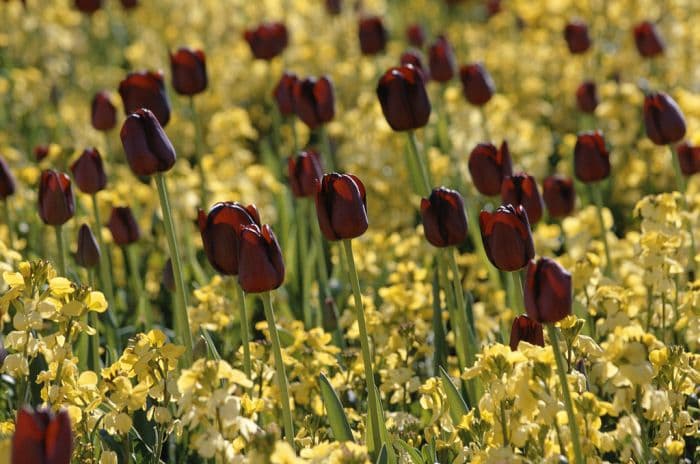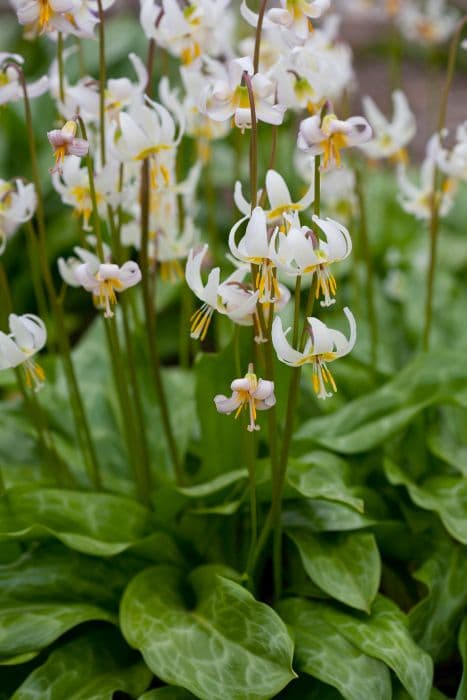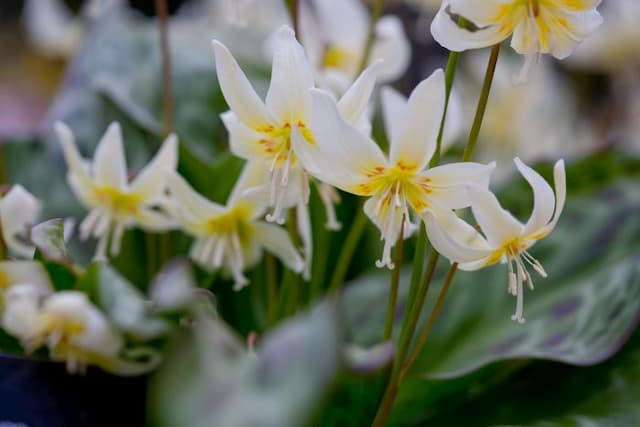Black Tulip Tulipa 'Queen of Night' (5)

ABOUT
Tulipa 'Queen of Night' is a striking and elegant variety of tulip known for its deep, velvety maroon or purple-black blooms that almost appear black in some light conditions, giving it a mysterious and dramatic look. The flowers are cup-shaped with a smooth, almost glossy surface and are carried on sturdy stems. Each petal is broad at the base and tapers to a point, sometimes with a slightly wavy edge, which adds to the luxurious texture of the flower. The foliage is green, strap-shaped, and usually has a greyish or bluish tinge, forming a nice contrast with the dark blossoms. This tulip typically blooms in the late spring, adding a touch of sophistication and depth to the garden. Tulipa 'Queen of Night' has a classic tulip shape that stands out due to its unusual color, making it a favorite among garden enthusiasts and a stunning choice for cut flower arrangements.
About this plant
 Names
NamesFamily
Liliaceae
Synonyms
Black Tulip, Queen of the Night Tulip
Common names
Tulipa 'Queen of Night'
 Toxicity
ToxicityTo humans
The plant commonly known as tulip can be toxic to humans if ingested. The toxicity mostly arises from compounds like tulipalin A and tulipalin B, which are found in the bulbs. If ingested, these compounds can cause symptoms such as nausea, vomiting, diarrhea, and dizziness. The most likely consequence of ingesting parts of the tulip, particularly the bulb, is gastrointestinal upset. Serious cases of poisoning are rare, but seeking medical attention would be advised if symptoms persist or are severe.
To pets
Tulip, including the 'Queen of Night' variety, is toxic to pets, especially dogs and cats. If ingested, the bulb, which contains the highest concentration of toxic substances like tulipalin A and tulipalin B, can lead to symptoms such as drooling, nausea, vomiting, and diarrhea. In severe cases, it may cause depression of the central nervous system, increased heart rate, and difficulty breathing. Ingestion of tulip parts by a pet warrants prompt veterinary attention to manage the symptoms and prevent more serious health consequences.
 Characteristics
CharacteristicsLife cycle
Perennials
Foliage type
Deciduous
Color of leaves
Green
Flower color
Maroon-black
Height
2 feet (60 cm)
Spread
6 inches (15 cm)
Plant type
Bulb
Hardiness zones
3
Native area
Central Asia
Benefits
 General Benefits
General Benefits- Aesthetic Value - The 'Queen of Night' tulip, with its deep purple, almost black flowers, adds striking beauty and a unique color contrast to gardens.
- Pollinator Attraction - They attract bees and other pollinators, which are essential for the health of ecosystems and the pollination of plants.
- Easy to Grow - These tulips are relatively easy to cultivate and can thrive in a variety of soil types, although they do best in well-drained soils.
- Seasonal Interest - They bloom in the spring, providing seasonal color and interest after a long winter.
- Breeding Potential - The 'Queen of Night' tulip can be used in breeding programs to create new varieties with unique characteristics.
- Floral Arrangements - These tulips are long-lasting cut flowers, making them popular choices for floral arrangements and bouquets.
 Medical Properties
Medical PropertiesThis plant is not used for medical purposes.
 Air-purifying Qualities
Air-purifying QualitiesThis plant is not specifically known for air purifying qualities.
 Other Uses
Other Uses- Tulip petals of 'Queen of Night' can be used as a natural dye for fabrics, providing a deep, rich color that mimics the flower's own hue.
- The strong stems of the 'Queen of Night' tulip can be incorporated into floral crafts, such as homemade wreaths or as a natural framework for small sculptures.
- Pressed 'Queen of Night' tulip petals can be used in crafting beautiful bookmarks, greeting cards, or in decoupage projects for a unique touch.
- During blooming season, these tulips can serve as a striking photography subject for artists and photographers, especially during the golden hour for dramatic lighting.
- Whole 'Queen of Night' flowers can be crystallized with egg whites and sugar to create exquisite, edible decorations for cakes and desserts.
- The tulip's bulbs can be experimented with in avant-garde cooking, provided they are prepared properly to remove any potential toxins.
- Given their dramatic appearance, 'Queen of Night' tulips can be used as inspiration for fashion designs, such as prints or textile patterns.
- 'Queen of Night' tulips can be used in educational settings to explain the biology of flowers, demonstrating the structure and development of a tulip bloom.
- These tulips create a striking contrast when used in black-and-white landscape designs, emphasizing the form and silhouette of the flowers rather than their color.
- 'Queen of Night' tulips can be used as a natural indicator of springtime in climate studies, with their blooming serving as a phenological signal.
Interesting Facts
 Feng Shui
Feng ShuiThe Black Tulip, as a representation of the water element with its deep purple, almost black color, can be placed in the North area of a space to foster career growth and fluidity, or in the East to support health and family growth, tapping into the wood element's energy.
 Zodiac Sign Compitability
Zodiac Sign CompitabilityThe Black Tulip is not used in astrology practice.
 Plant Symbolism
Plant Symbolism- Mystery - The Tulip 'Queen of Night', with its deep purple, almost black flowers, is often associated with the mysterious due to its unusual and enigmatic color.
- Power - Its regal bearing and rare hue lend it an air of power and majesty, often symbolizing strength and resilience.
- Royalty - This tulip's name itself conjures images of nobility and its luxurious appearance reinforces the symbolism of royalty and elegance.
- Elegance - Because of its sophisticated look, the 'Queen of Night' is considered an emblem of grace and refined beauty.
- Transformation - The bloom's distinctive contrast to traditional tulip colors can represent a significant change or a shift in perception and understanding.
 Water
WaterFor the Queen of the Night tulip, water sparingly during the growing season, ensuring that the soil is moist but not saturated. The tulip bulbs require a dry, dormant period in summer when watering should be ceased completely. During the active growing phase, water these tulips once a week with about half a gallon per square yard, depending on rainfall and soil conditions. Overwatering can lead to bulb rot, so it is important to allow the soil to dry out slightly between waterings. If rainfall is sufficient, additional watering may not be necessary.
 Light
LightThe Queen of the Night tulip thrives in full sunlight to partial shade. To ensure the best growth and flowering, plant them in a location that receives at least six hours of direct sunlight per day. These tulips can tolerate light shade, especially in hot climates, but too much shade can lead to weak stems and fewer blooms.
 Temperature
TemperatureQueen of the Night tulips prefer a temperate climate, thriving best in temperatures between 50°F and 70°F. They can tolerate a temporary dip to as low as 20°F, but extended exposure to temperatures below this can harm the bulbs. During their dormant period in summer, they can survive higher temperatures, especially if the bulbs are kept dry.
 Pruning
PruningPruning of Queen of the Night tulips involves removing spent blooms and yellowing leaves after flowering. Deadhead the flowers as soon as they start to fade to direct energy into the bulb for next year's growth. Once the foliage has turned yellow and died back, usually several weeks after flowering, it can be cut back to the ground. This is typically done once a year, after the blooming period.
 Cleaning
CleaningAs needed
 Soil
SoilThe Black Tulip thrives in well-draining, fertile soil with a pH of 6.0 to 7.0. A mix of loamy garden soil, compost, and sandy material like perlite or grit creates an ideal environment for these tulips, providing both nutrients and proper drainage to avoid bulb rot.
 Repotting
RepottingBlack Tulips, as bulbous plants, do not require repotting like other houseplants. Instead, they should be lifted and divided every 3 to 5 years once the blooming starts to diminish or the clumps become overcrowded.
 Humidity & Misting
Humidity & MistingBlack Tulips prefer outdoor conditions where humidity is generally not a concern. These tulips are tolerant of a wide range of humidity levels and do not require specific humidity adjustments.
 Suitable locations
Suitable locationsIndoor
Plant bulbs in pots with drainage; place in cool, sunny spot.
Outdoor
Plant bulbs 4-6 inches deep in fall; full sun to partial shade.
Hardiness zone
3-8 USDA
 Life cycle
Life cycleThe tulip 'Queen of Night' begins its life cycle as a bulb, which lies dormant underground through the summer. In the fall, cooler temperatures and moisture trigger the bulb to develop roots and prepare for spring growth. Come spring, stems, leaves, and buds emerge from the bulb, with the plant eventually flowering, showcasing its iconic deep purple, almost black blossoms. After blooming, the flowers fade, and the plant channels energy back into the bulb as the foliage dies back. The 'Queen of Night' bulb enters dormancy once again through the summer, conserving energy for the next growing season. This cycle repeats annually, with bulbs potentially producing offsets or being divided by gardeners to propagate new plants.
 Propogation
PropogationPropogation time
Late summer
The Tulip 'Queen of Night', known for its dramatic deep purple, almost black flowers, is most commonly propagated through bulb division. This method is ideally performed in the fall when the plant is dormant. Gardeners should carefully dig up the bulbs, taking care not to damage them, and then gently separate any small bulbs, often referred to as bulblets or offsets, from the parent bulb. These offsets are miniature bulbs that have formed at the base of the parent bulb and are the key to propagating 'Queen of Night' tulips. Once separated, the offsets should be planted immediately at a depth of about 6 to 8 inches (15 to 20 centimeters) with the pointed end up and spaced approximately 4 to 6 inches (10 to 15 centimeters) apart to allow room for growth, ensuring the continuation of this spectacular tulip variety in the garden for seasons to come.









